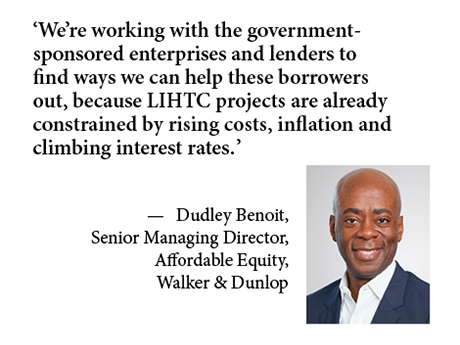New income limits for low-income and very-low-income housing in 2023 represent a mixed blessing for the industry’s providers, who gain more potential renters but face ubiquitous caps that restrain their ability to adjust rents.
The U.S. Department of Housing and Urban Development (HUD) publishes the income limits annually based on changes in each housing area’s median income, and typically places caps on outlier markets to prevent wide year-to-year swings. From 2010 through 2021, about 10 percent of areas were capped each year. Also in that period, the caps predictably checked the increase in an area’s qualifying income levels to no more than double the annual percent change in national median income. HUD published national median income based on three-year-trailing American Community Survey (ACS) data that HUD adjusted forward using the Consumer Price Index (CPI).
In 2022, however, HUD omitted the CPI factor and based limits on historical survey data alone, producing lower results for median incomes and a smaller percentage change to be doubled into a cap. Even so, calculated incomes rose significantly, spurring HUD to cap increases in 57 percent of areas.
Industry experts had predicted HUD would add the CPI adjustment back into its calculations in 2023, resulting in a cap of about 12 percent to reflect the doubling of median-income gains in the year just ended. Instead, HUD again used only the most recent ACS survey data and calculated limits and caps from median incomes in 2019 and 2020, without adjustment for inflation since that time.
And instead of capping only outlier markets, HUD applied caps in 87 percent of the nation’s housing areas. Income limits across the country increased, on average, 5.45 percent for 2023, or less than half the adjustment predicted by industry experts.
Recalculating Revenues
HUD income levels ultimately determine the maximum rent landlords can charge for subsidized low-income housing, observes Dudley Benoit, senior managing director, affordable equity, at Walker & Dunlop. That means the widely applied caps for 2023 also constrain potential revenue at affected properties, which in turn limits the amount of available debt financing.
“The long and short of it is that Low-Income Housing Tax Credit (LIHTC) developers and landlords are going to have less income to run their properties than expected,” Benoit says. “That affects operations. That alters how much debt is available to a project. The changes run through the entire operation.”
As one of the largest commercial real estate finance and advisory services firms in the United States, Walker & Dunlop works with many LIHTC owners and developers that paused projects when HUD published numbers for 2023. Some developers no longer qualify for loan amounts they had expected to receive and are reworking plans to fit available financing.
Smaller allowable rent increases are also compelling some LIHTC owners and operators to recalculate budgets. Amid rising operating costs driven by rapid inflation, rising interest rates, skyrocketing insurance premiums and other factors, many landlords had penciled in double-digit rent increases that industry experts believed would align with HUD’s 2023 guidance. Like developers, many LIHTC landlords are recalculating how to proceed under the latest parameters.
Case Study: Caps and Capitalization
To illustrate how HUD’s income limit methodology affects financing, Benoit points to a 320-unit LIHTC development in southwestern Florida. Earlier this year, the developer’s team was applying for a first mortgage predicated on a net operating income (NOI) of $2.57 million. That’s how much the project would generate with a 5.92 percent rent increase, which was the maximum rent increase allowed in 2022 under a HUD cap.
In May, however, HUD’s reliance on 2019 and 2020 data brought only a 3.9 percent increase in the area’s income limit. That proportionally reduced the project’s achievable rent and tightened its projected cashflow to a little more than $2.44 million.
“From the developer’s perspective, the unexpectedly slight rise in the area’s income eligibility for 2023 shaved nearly 5 percent from the property’s net operating income,” Benoit says. “The NOI reduction resulted in a haircut of approximately $1.25 million in available proceeds on the first mortgage.”
Finding Solutions
Developers and LIHTC owners facing unexpected challenges due to HUD’s caps may find a solution in strategies that have helped borrowers finance projects in the past, Benoit says.
“The more obvious solution to a reduced revenue projection is to contribute or attract more equity into a project,” Benoit says. “You will also see developers going back to state allocating agencies or local authorities for additional funds. They may ask the community to cover more of the project’s soft costs, such as architect and engineering fees or office administration overhead, for example.”
Walker & Dunlop is drawing upon its relationships and experience to help clients offset perceived losses, Benoit says. Potential solutions include renegotiating amortization schedules and other loan terms to strengthen net income, which lenders use in calculating an asset’s collateral value and maximum loan amount.
“We’re working with the government-sponsored enterprises and lenders to find ways we can help these borrowers out, because LIHTC projects are already constrained by rising costs, inflation and climbing interest rates,” he says.
Strategies that have proven effective for some clients include working within valuation models to support higher property values on LIHTC projects, which can help the borrower qualify for additional financing. Alternatively, the advisory team may suggest adjustments that boost the initial return available to investors, enabling the developer or owner to command a higher buy-in price and larger total investment.
For many LIHTC properties in capped areas, success will depend on an accumulation of small improvements, Benoit observes. “At the end of the day, we’re trying to get more debt or equity dollars into the developer’s hands to offset any limitation on their expected rents.”
— By Matt Hudgins. Walker & Dunlop is a content partner of REBusinessOnline. For more articles from and news about Walker & Dunlop, click here.


